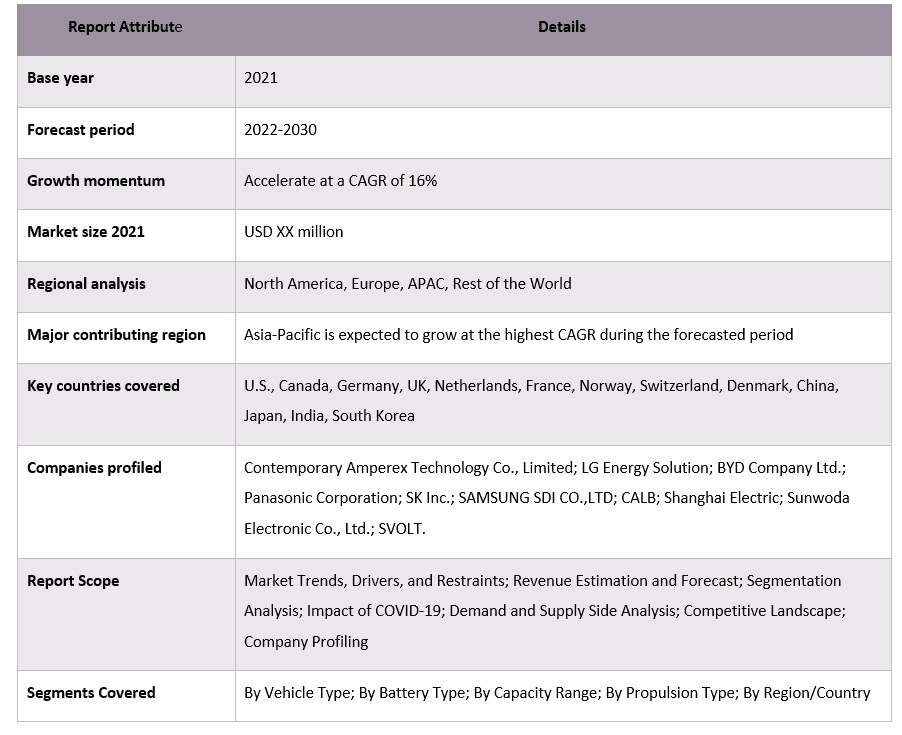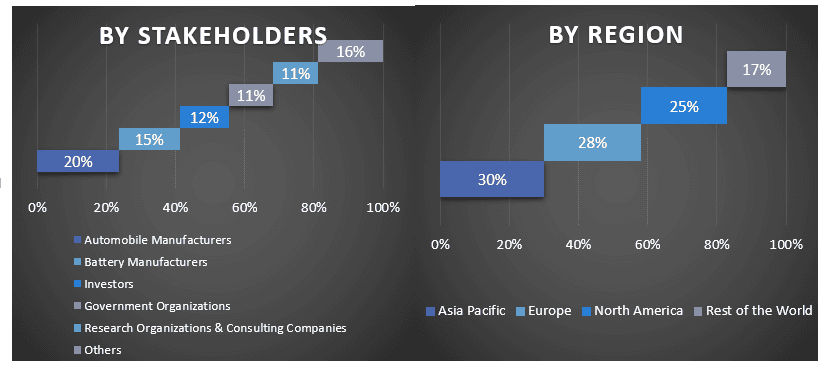- Home
- About Us
- Industry
- Services
- Reading
- Contact Us
Electric Vehicle Battery System Market: Current Analysis and Forecast (2022-2030)
Emphasis on Vehicle Type (Scooter and Motorcycle), Battery Type (Lithium ion Battery, Lithium Titanium Oxide Battery, and Lead Acid Battery), and Charging Type (Plug In Charging and Battery Swap) Region/Country.

The electric vehicle battery system market is expected to grow at a strong CAGR of around 16% during the forecast period 2022-2028.
The electric vehicle battery system is one of the most fundamental parts of electric vehicles accounting for almost 25-40 % of the total cost of the vehicle and almost 25% of the vehicle’s weight. A high-performing battery system is needed in order to give the vehicle good ranges and operate under high-stress conditions and different types of weather conditions along with keeping the battery safe, not letting it get overheated, or over-discharge and also responsible for safe charging and keeping the battery healthy and hence a large number of investments are done on the designing and R&D work on battery systems as from governments to OEMs, everybody is aware of the fact that the electrification at mass scale can only be achieved with perfected battery technology. For instance, according to a joint study done by the European patent office(EPO) and the International energy agency(IEA), Between 2005 and 2018, patenting activity in batteries and other electricity storage technologies increased at an average annual rate of 14% worldwide, growing four times faster than the average of all technology fields. According to the report, Innovation in batteries and electricity storage – a global analysis based on patent data, batteries account for nearly 90% of all patenting activity in the field of electricity storage. Rechargeable lithium-ion battery advancements are the main factors driving the increase in innovation aimed at improving power output, durability, charge/discharge speed and recyclability. Furthermore, as the automakers are producing more and more electric cars and trucks, the demand for batteries and battery systems is also rising and to cater to this demand, manufacturers are already expanding their operations and capacity For instance, on Aug 2022 – Toyota Battery Manufacturing North Carolina, announced its newest North American operation in which it will get an additional USD 2.5 billion investment, according to Toyota. (TBMNC). This investment expands capacity to enable the production of battery electric vehicle (BEV) batteries. The factory will make batteries for hybrid electric vehicles (HEVs) and battery electric vehicles (BEVs), with production set to start in 2025. The Toyota Motor Corporation pledged a global investment in electrification efforts of over USD 70 billion last year. Today, TMC announced a future battery manufacturing commitment of up to USD 5.6 billion, which includes the new North Carolina investment, as part of this aspirational aim.
Some of the major players operating in the market include Contemporary Amperex Technology Co., Limited; LG Energy Solution; BYD Company Ltd.; Panasonic Corporation; SK Inc.; SAMSUNG SDI CO.,LTD; CALB; Shanghai Electric; Sunwoda Electronic Co., Ltd.; SVOLT
Insights Presented in the Report
“Amongst propulsion type, BEV segment held a dominating share of the market”
Based on propulsion type, the market is segmented into Battery electric vehicles (BEV), Hybrid electric vehicles (HEV), Plug-in hybrid electric vehicles (PHEV), and Fuel cell electric vehicles (FCEV). Among these BEV segments holds the majority of the market share and also going to grow at a significant CAGR, owing to reasons like, the perception that is around that electric vehicles benefit the environment more than plug-in hybrid vehicles as BEVs don’t use any gasoline and this is big deal among the majority of the consumers, also electric vehicles save more money of the consumers than the plug-in hybrid vehicles, another positive thing about the fully electric vehicle is they are fun to drive. The main USP of plug-in hybrid over BEV used to be, with the PHEVs consumers don’t have to worry about the range but over time with the rising fast charging infrastructure and BEVs coming with high capacity batteries offering longer ranges and reduced charging time now again the PHEVs have taken the back seat as compared to the popularity of the BEVs. For instance, according to EV volumes, PHEVs stood for 27 % of global Plug-in sales in 2022 compared to 29 % in 2021. While their sales volumes still increased, their share in the PEV mix is in decline, facing headwinds from incentive cuts and improving BEV offers. Sales growth is increasingly depending on the degree of electrification. While BEVs grew by +59 % and PHEVs by +46 %, non-chargeable Full Hybrids grew by +15 % and Mild Hybrids by +1 % y-o-y. Global sales of vehicles which can be charged from the grid (10.5 million) were higher than for non-chargeable vehicles (8.4 million) for the first time in 2022. ICE-only vehicle sales declined by -7 %; their share in global light vehicle sales is 76.8 %, compared to 82.2 % in 2021. FCEV remain irrelevant for the electrification of light vehicles; their deliveries stagnated at 15 400 units in 2022, which is 0.02 % of the global, annual light vehicle volume.
Electric Vehicle Battery System Market Report Coverage

“Asia Pacific dominated the electric vehicle battery system market in 2021.”
The electric vehicle battery system market in the Asia Pacific region held the largest market share and is expected to maintain its growth throughout the forecast period. Major countries in Asia Pacific like India, China, Thailand etc are going to be the biggest market for electric vehicles. With the rising governments effort for curbing CO2 emissions and become carbon neutral in the due course of time and also with better battery technologies and offerings from the OEMs together creating a great value proposition for the customers along with the feel-good factor of riding an EV is their contribution in saving the planet has boosted the ambition and enthusiasm of the consumers for owning an EV. Moreover rising charging infrastructure, which once used to be a rare sighting is now started appearing more often hence further increasing the reliability and trust of the consumers in the EV ecosystem that they use to have on the ICE vehicles and their infrastructure. Also rising income and more people joining the workforce of these countries, is increasing both the need for mobility and also the affordability of the people which is further boosting the demand of electric vehicles which will lead to rising battery system demand. For instance, As per the retail sales numbers of India, from total sales of 28,280 units in CY2019, surging consumer demand for electric two-wheelers has seen sales in CY2022 charge past the 6,00,000-unit mark at 6,15,365 units, recording 305 per cent YoY growth (CY2021: 1,51,685 units), and accounting for 73 per cent of total electric two-wheeler sales of 8,46,259 units over the past 10 years
Reasons to buy this report:
- The study includes market sizing and forecasting analysis validated by authenticated key industry experts.
- The report presents a quick review of overall industry performance at one glance.
- The report covers an in-depth analysis of prominent industry peers with a primary focus on key business financials, product portfolios, expansion strategies, and recent developments.
- Detailed examination of drivers, restraints, key trends, and opportunities prevailing in the industry.
- The study comprehensively covers the market across different segments.
- Deep dive regional level analysis of the industry.
Customization Options:
The global electric vehicle battery system market can further be customized as per the requirement or any other market segment. Besides this, UMI understands that you may have your own business needs, hence feel free to connect with us to get a report that completely suits your requirements.
Table of Content
Research Methodology for the Electric Vehicle Battery System Market Analysis (2022-2028)
Analyzing the historical market, estimating the current market, and forecasting the future market of the global electric vehicle battery system market were the three major steps undertaken to create and analyze the adoption of electric vehicle battery systems in major regions globally. Exhaustive secondary research was conducted to collect the historical market numbers and estimate the current market size. Secondly, to validate these insights, numerous findings and assumptions were taken into consideration. Moreover, exhaustive primary interviews were also conducted, with industry experts across the value chain of the global electric vehicle battery system market. Post assumption and validation of market numbers through primary interviews, we employed a top-down/bottom-up approach to forecasting the complete market size. Thereafter, market breakdown and data triangulation methods were adopted to estimate and analyze the market size of segments and sub-segments of the industry pertains to. Detailed methodology is explained below:
Analysis of Historical Market Size
Step 1: In-Depth Study of Secondary Sources:
Detail secondary study was conducted to obtain the historical market size of the electric vehicle battery system market through company internal sources such as annual reports & financial statements, performance presentations, press releases, etc., and external sources including journals, news & articles, government publications, competitor publications, sector reports, third-party database, and other credible publications.
Step 2: Market Segmentation:
After obtaining the historical market size of the electric vehicle battery system market, we conducted a detailed secondary analysis to gather historical market insights and share for different segments & sub-segments for major regions. Major segments are included in the report as vehicle type, battery type, capacity range, and propulsion type. Further country-level analyses were conducted to evaluate the overall adoption of testing models in that region.
Step 3: Factor Analysis:
After acquiring the historical market size of different segments and sub-segments, we conducted a detailed factor analysis to estimate the current market size of the electric vehicle battery system market. Further, we conducted factor analysis using dependent and independent variables such as vehicle type, battery type, capacity range, and propulsion type of the electric vehicle battery system market. A thorough analysis was conducted for demand and supply-side scenarios considering top partnerships, mergers and acquisitions, business expansion, and product launches in the electric vehicle battery system market sector across the globe.
Current Market Size Estimate & Forecast
Current Market Sizing: Based on actionable insights from the above 3 steps, we arrived at the current market size, key players in the global electric vehicle battery system market, and market shares of the segments. All the required percentage shares split, and market breakdowns were determined using the above-mentioned secondary approach and were verified through primary interviews.
Estimation & Forecasting: For market estimation and forecast, weights were assigned to different factors including drivers & trends, restraints, and opportunities available for the stakeholders. After analyzing these factors, relevant forecasting techniques i.e., the top-down/bottom-up approach were applied to arrive at the market forecast for 2028 for different segments and sub-segments across the major markets globally. The research methodology adopted to estimate the market size encompasses:
- The industry’s market size, in terms of revenue (USD) and the adoption rate of the electric vehicle battery system market across the major markets domestically
- All percentage shares, splits, and breakdowns of market segments and sub-segments
- Key players in the global electric vehicle battery system market in terms of products offered. Also, the growth strategies adopted by these players to compete in the fast-growing market
Market Size and Share Validation
Primary Research: In-depth interviews were conducted with the Key Opinion Leaders (KOLs) including Top Level Executives (CXO/VPs, Sales Head, Marketing Head, Operational Head, Regional Head, Country Head, etc.) across major regions. Primary research findings were then summarized, and statistical analysis was performed to prove the stated hypothesis. Inputs from primary research were consolidated with secondary findings, hence turning information into actionable insights.
Split of Primary Participants in Different Regions

Market Engineering
The data triangulation technique was employed to complete the overall market estimation and to arrive at precise statistical numbers for each segment and sub-segment of the global electric vehicle battery system market. data was split into several segments & sub-segments post studying various parameters and trends in the areas of the vehicle type, battery type, capacity range, and propulsion type in the global electric vehicle battery system market.
The main objective of the Global Electric Vehicle Battery System Market Study
The current & future market trends of the global electric vehicle battery system market were pinpointed in the study. Investors can gain strategic insights to base their discretion for investments on the qualitative and quantitative analysis performed in the study. Current and future market trends determined the overall attractiveness of the market at a regional level, providing a platform for the industrial participant to exploit the untapped market to benefit from a first-mover advantage. Other quantitative goals of the studies include:
- Analyze the current and forecast market size of the electric vehicle battery system market in terms of value (USD). Also, analyze the current and forecast market size of different segments and sub-segments
- Segments in the study include areas of the vehicle type, battery type, capacity range, and propulsion type.
- Define and analysis of the regulatory framework for the electric vehicle battery system industry
- Analyze the value chain involved with the presence of various intermediaries, along with analyzing customer and competitor behaviors of the industry
- Analyze the current and forecast market size of the electric vehicle battery system market for the major region
- Major countries of regions studied in the report include Asia Pacific, Europe, North America, and the Rest of the World
- Company profiles of the electric vehicle battery system market and the growth strategies adopted by the market players to sustain in the fast-growing market
- Deep dive regional level analysis of the industry
Related Reports
Customers who bought this item also bought










